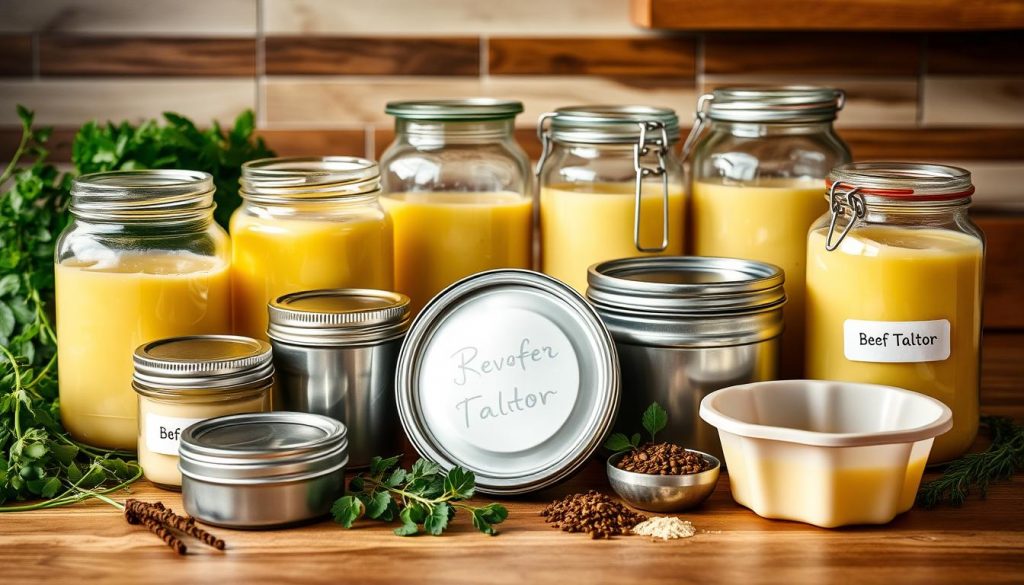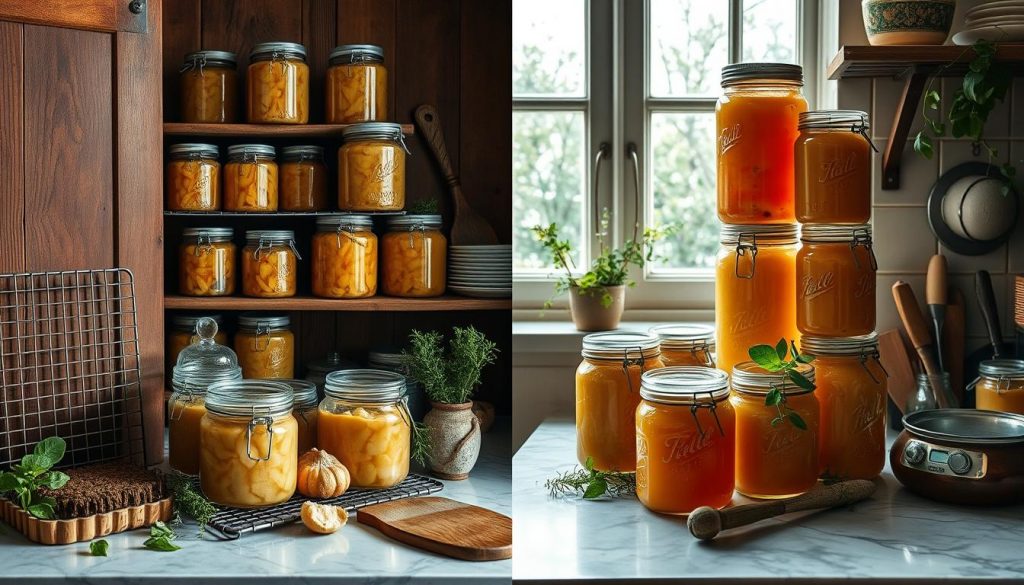Beef tallow storage has caught the attention of food lovers and health-conscious cooks. Let’s explore this traditional fat source and its shelf life. Our guide will help you master the art of preserving beef fat.
We’ll uncover the secrets of proper fridge storage for beef tallow. This will ensure you get the most out of this versatile ingredient.
Knowing tallow shelf life is key for using this nutrient-rich fat in cooking. We’ll look at factors that affect how long beef tallow lasts in the fridge. You’ll also learn expert tips to keep it fresh.
This guide is for both seasoned chefs and curious home cooks. You’ll gain the knowledge to make the most of your beef tallow.
Key Takeaways
- Proper beef tallow storage extends its usability
- Fridge storage significantly increases tallow shelf life
- Airtight containers are essential for preserving beef fat
- Temperature control is key to maintaining tallow freshness
- Regular checks help prevent using spoiled tallow
- Clean handling practices enhance storage duration
Understanding Beef Tallow: A Traditional Fat Source
Beef tallow is a traditional cooking fat used for centuries. It’s rendered beef fat with a unique flavor profile. This versatile ingredient is popular in many culinary applications.
What Is Beef Tallow?
Beef tallow comes from cattle fat. It’s made by slowly heating raw beef fat until it melts. The melted fat is then strained to remove impurities.
The result is pure, white rendered beef fat. It solidifies at room temperature, making it easy to store.
Nutritional Benefits of Beef Tallow
Beef tallow can be a healthy cooking oil option. It’s packed with vitamins A, D, E, and K. It also contains conjugated linoleic acid (CLA), which may offer health benefits.
Historical Uses and Modern Applications
Beef tallow was once a kitchen staple for frying, baking, and spreading. Now, it’s making a comeback in culinary circles. Chefs love its high smoke point and rich flavor.
It’s also finding new uses outside the kitchen. Beef tallow is now used in skincare products and artisanal soaps.
- Frying: Ideal for deep-frying due to its high smoke point
- Baking: Adds richness to pastries and pie crusts
- Sautéing: Enhances flavor in various dishes
- Non-culinary: Used in soap making and skincare products
Knowing beef tallow’s properties helps you use it best. Proper handling can extend its shelf life significantly. Let’s explore how to store this versatile fat.
The Science Behind Tallow Preservation
Tallow’s longevity is fascinating. Let’s explore the key factors that make it last so long.
Chemical Composition
Beef tallow is mostly saturated fats. This gives tallow its solid form at room temperature. Saturated fats resist oxidation, which causes rancidity in fats.
Natural Preservation Properties
Tallow has natural antioxidants that protect it from spoiling. These compounds slow down oxidation and prevent harmful free radicals. This makes tallow a self-preserving fat, extending its use.
Factors Affecting Shelf Life
Several elements influence tallow’s freshness:
- Oxygen exposure: Air contact can accelerate oxidation, leading to rancidity.
- Temperature: Heat speeds up chemical reactions, potentially shortening tallow’s lifespan.
- Light: UV rays can break down fats, affecting tallow’s quality over time.
Managing these factors can extend tallow’s shelf life. Proper storage in airtight containers helps maintain freshness. Keep tallow away from heat and light.
| Storage Condition | Estimated Shelf Life |
|---|---|
| Room Temperature (70°F) | 3-6 months |
| Refrigerated (40°F) | 6-12 months |
| Frozen (0°F) | 1-2 years |
How Long Does Beef Tallow Last in the Fridge
Beef tallow can stay fresh for 6 to 12 months in the fridge. This long shelf life makes it great for home cooks. Proper storage is key to keeping tallow fresh.
Tallow’s lifespan depends on several things. Clean rendering, airtight containers, and steady fridge temps all matter. Following best practices helps tallow last longer.
| Storage Method | Temperature | Shelf Life |
|---|---|---|
| Refrigeration | 35°F – 40°F | 6-12 months |
| Room Temperature | 60°F – 70°F | 1-3 months |
| Freezer | 0°F or below | Up to 2 years |
Store tallow in a clean, airtight container for best results. Glass jars or food-grade plastic work well. Keep it away from strong smells in your fridge.
Check your tallow often. Look for off-odors or color changes. These could mean it’s gone bad. Regular checks help you enjoy tallow safely for months.
Proper Storage Containers for Beef Tallow
Choosing the right container keeps beef tallow fresh longer. Let’s look at options for storing your tallow effectively.
Best Container Materials
Glass containers are ideal for storing beef tallow. They don’t absorb smells and are simple to clean.
BPA-free plastic containers can work too. Stainless steel is another great choice, offering strength and temperature resistance.

Airtight Storage Solutions
Airtight containers are vital for tallow freshness. They stop oxidation and protect against moisture, which can cause spoiling.
Look for containers with secure lids. Vacuum-sealed bags offer extra protection for your tallow.
Size and Portion Considerations
Portion control matters when storing beef tallow. Smaller containers let you thaw only what you need, reducing waste.
Think about how much you usually use. Divide tallow into right-sized portions before storing.
| Container Type | Pros | Cons |
|---|---|---|
| Glass jars | Odor-resistant, easy to clean | Breakable |
| Plastic containers | Lightweight, affordable | May absorb odors over time |
| Stainless steel | Durable, temperature-resistant | More expensive |
| Vacuum-sealed bags | Space-saving, airtight | Single-use plastic |
Signs of Spoiled Beef Tallow
Spotting spoiled beef tallow is vital for safe food handling. Let’s explore key signs to look for when checking your stored tallow.
Fresh tallow is usually creamy white or pale yellow. Watch for discoloration like dark spots or graying. These changes may signal spoilage.
Fresh tallow has a mild, neutral scent. Sour, musty, or unpleasant smells often indicate the tallow has gone bad.
Good tallow should be firm at room temperature. Unusual softness, greasiness, or consistency changes may mean it’s spoiled.
- Visual cues: Discoloration or mold growth
- Olfactory signs: Sour or rancid odors
- Texture changes: Unusual softness or greasiness
- Taste (if safe): Bitter or off-flavors
When unsure, it’s best to play it safe. If your tallow shows any of these signs, throw it away.
Room Temperature vs. Refrigeration Storage
Temperature control is vital for tallow preservation. Let’s examine how storage methods affect beef tallow’s longevity. We’ll also provide insights on optimal pantry storage conditions.
Temperature Impact on Shelf Life
Storage temperature greatly influences beef tallow’s freshness. At room temperature, tallow lasts several months. Refrigeration extends its shelf life considerably.
Cooler temperatures slow down oxidation. This keeps the fat stable for longer periods.
| Storage Method | Estimated Shelf Life | Best For |
|---|---|---|
| Room Temperature | 3-6 months | Short-term use |
| Refrigeration | 6-12 months | Long-term storage |
| Freezing | Up to 2 years | Extended preservation |
Humidity Considerations
Humidity can affect tallow quality. High moisture promotes mold growth and rancidity. For optimal pantry storage, keep tallow in a cool, dry place.
If your kitchen is humid, refrigeration might be better for tallow preservation.

Light Exposure Effects
Light exposure can degrade tallow quality over time. UV rays break down fats, leading to off-flavors and reduced nutritional value.
Store tallow in opaque containers or dark pantry spaces. This simple step can significantly extend its shelf life.
Freezing Beef Tallow: Extended Storage Guide
Freezing beef tallow is a top-notch way to store it long-term. Proper freezer storage can extend tallow’s shelf life significantly. Beef tallow can last up to a year in cool, dark places.
Freezing pushes this lifespan even further. It’s a fantastic option for tallow preservation enthusiasts.
- Portion the tallow into usable amounts
- Use airtight, freezer-safe containers
- Remove as much air as possible before sealing
- Label containers with date and quantity
- Store at 0°F (-18°C) or below
For thawing, move frozen tallow to the refrigerator 24 hours before use. This slow thaw keeps its quality and texture intact.
| Storage Method | Temperature | Approximate Shelf Life |
|---|---|---|
| Room Temperature | 60-70°F (15-21°C) | 1-3 months |
| Refrigeration | 32-40°F (0-4°C) | 6-12 months |
| Freezer | 0°F (-18°C) or below | 1-3 years |
These freezer storage tips help preserve tallow’s quality and nutrients. You can enjoy your tallow for longer periods without worry.
Tips for Maximizing Tallow Shelf Life
Proper tallow handling and storage are vital for maintaining its quality. These tips will help extend your beef tallow’s shelf life and ensure food safety.
Handling Best Practices
Cleanliness is crucial when working with tallow. Use clean utensils and containers to prevent contamination. Avoid introducing moisture or food particles to prevent spoilage.
Proper rendering and storage can extend tallow’s shelf life significantly. With the right care, tallow can last for months or even years.
Temperature Control Methods
Maintaining the right temperature is key for tallow preservation. Store it in a cool, dark place away from sunlight and heat. Refrigeration is ideal for long-term storage.
Freezing can extend tallow’s life even further. Consider portioning tallow before freezing for easier use later.
Contamination Prevention
To prevent contamination, follow these steps:
- Use airtight containers to protect tallow from air and moisture
- Label containers with the date of storage
- Avoid double-dipping or using dirty utensils
- Store tallow away from strong-smelling foods to prevent odor absorption
These storage techniques will keep your tallow fresh and safe. You’ll be able to use it in various culinary applications with confidence.
Commercial vs. Homemade Tallow Storage
Storing beef tallow differs between store-bought and homemade varieties. Let’s explore these differences to help you choose wisely for your kitchen.
Store-bought tallow contains preservatives to extend shelf life. These additives maintain freshness and prevent spoilage. Homemade tallow uses natural preservation methods, which may affect its longevity.
Commercial producers use advanced packaging to seal in freshness. Their containers keep out air and light, preventing rancidity. At home, we must be careful with storage containers to achieve similar results.
| Aspect | Store-Bought Tallow | DIY Tallow |
|---|---|---|
| Preservation Method | Added preservatives | Natural preservation |
| Shelf Life | Generally longer | Varies, typically shorter |
| Packaging | Professional, airtight | Depends on home storage |
Store-bought tallow offers convenience and longer shelf life. Homemade tallow gives us control over ingredients and processing. Understanding these differences helps us make informed decisions about tallow storage.
Rendering and Storage Preparation Methods
Tallow rendering and storage are vital skills for using beef fat long-term. This guide will help you create and keep high-quality tallow fresh for extended use.
Clean Rendering Techniques
Start by choosing top-notch beef fat. Cut it into small pieces and place in a slow cooker. Cook on low for 4-6 hours, stirring now and then.
The fat will melt, separating from any meat bits. Strain the liquid through a cheesecloth to remove any impurities.
Cooling and Packaging Steps
Let the strained tallow cool a bit. Pour it into clean, dry jars while it’s still liquid. Allow the tallow to reach room temperature before sealing the jars.
This cooling step is crucial. It prevents condensation, which can lead to spoilage.
Storage Preparation Tips
Clean and dry all utensils and containers thoroughly. Label each jar with the rendering date. Store in a cool, dark place for short-term use.
For longer shelf life, keep the tallow in the refrigerator. Proper straining and cooling greatly extend tallow’s usability.
- Use airtight containers to prevent oxidation
- Keep tallow away from strong odors
- Avoid plastic containers that may leach chemicals
These methods will help you create pure, long-lasting tallow. It’s perfect for cooking, soap making, and other uses.
Common Storage Mistakes to Avoid
Storing beef tallow incorrectly can lead to spoilage. Using containers that aren’t airtight is a major error. This allows air to seep in, causing the fat to oxidize faster.
To prevent this, always use tightly sealed jars or containers. Proper storage keeps tallow fresh for longer periods.
Exposing tallow to light and heat is another preservation mistake. Avoid keeping it on a sunny kitchen counter. Instead, store your tallow in a cool, dark place.
The fridge or a pantry are ideal locations for tallow storage. These places protect it from harmful elements.
Cleanliness is crucial when storing tallow. Using dirty utensils or containers can introduce bacteria. This leads to food safety risks.
Always use clean, dry tools and containers when handling tallow. These practices ensure its quality and safety.




